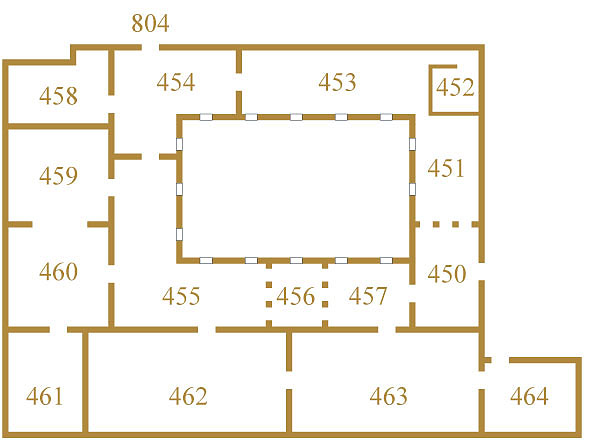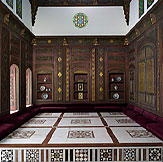Room-by-Room Descriptions of the New Galleries

Gallery 450: Patti Cadby Birch Gallery—the introductory gallery—will showcase masterpieces from across the collection in the major media employed in the art of the Islamic world: pottery, carpets and textiles, jeweled arts, calligraphy, painting, and architectural elements. The styles, themes, and motifs that visitors encounter here will recur in successive rooms, thereby connecting distinct cultures. This gallery is one of three rooms named in honor of Patti Cadby Birch. The others are galleries 456 and 457.
Gallery 451: Arab Lands and Iran in the Umayyad and Abbasid Periods (7th–13th centuries) will explore early Islamic art, focusing primarily on the Umayyad dynasty (661–750), whose capital was Damascus, and the Early Abbasid dynasty (750–ca. 900), which was based in Baghdad. Also highlighted will be pre-Islamic traditions from ancient Rome, Byzantium, and Persia that evolved into Islamic art under the Umayyads. During the Early Abbasid period, the melding of influences from as far away as China and India resulted in a golden age of creativity. Among the many treasures on view will be an outstanding selection of manuscripts and early Qur’an pages in Kufic script. These will be displayed alongside textiles from all reaches of the empire, from Yemen to Egypt, as well as ceramics, including luster-painted pottery; wooden doors in the beveled style from Samarra in Iraq; metalwork; and glass.
Gallery 452: Nishapur and the Sabz Pushan Site will present materials that were excavated by the Iranian Expedition of The Metropolitan Museum of Art in several digs from 1935 to 1947. The most outstanding objects are a group of architectural decorations from an excavated mound known locally as Tepe Sabz Pushan (“The Green-covered Mound”). New scholarship has made it possible to reconstruct with accuracy the walls of a small room, now called the Sabz Pushan Room, decorated with finds from the site including tall carved plaster dadoes, wall painting fragments, and stucco elements called muqarnas, the stalactite decoration characteristic of many Islamic buildings.
The reinstallation of this gallery is made possible through the generosity of the Iranian-American community. Conservation of glass, ceramic, and stucco objects from the Nishapur excavation is made possible by a grant from the U.S. Institute of Museum and Library Services.
Gallery 453: Iran and Central Asia (9th–13th centuries) will focus on the far-reaching impact of the Abbasid style in the eastern Islamic world. Included will be the artistic achievements of the 11th-century Ghaznavid and 12th-century Seljuq Sultans, whose patronage ushered in a brilliant and inventive period of art and culture in Iran and Central Asia. Among the highlights will be luster-painted and other ceramic vessels from 12th-century Kashan and Rayy, a pair of life-size statues of palace guards, and an early 13th-century monumental bronze incense burner in the shape of a lion.
Gallery 454: Egypt and Syria (10th–16th centuries) will feature a comprehensive display of the three major periods in the medieval history of Cairo: the Fatimid (909–1171), Ayyubid (1169–1260), and Mamluk (1250–1517). Known for its history, rich culture, and diverse population, Cairo has played a vital role in the artistic life of the Islamic world for centuries. Under Mamluk rule, Cairo became one of the wealthiest cities in the Near East and a hub of artistic and intellectual activity in the Arab world. On display will be an outstanding selection of woodwork, gold jewelry from the Fatimid period, textiles, splendid inlaid metalwork and enameled glass from the Mamluk period, and luster-painted ceramics. This gallery will also offer another point of entry into the whole suite, from the adjoining Orientalism gallery, which is part of the adjacent 19th- and Early 20th-Century European Paintings and Sculpture Galleries.
Gallery 456: Patti Cadby Birch Court, based on Moroccan late medieval design, is under construction by craftsmen from Fez as an intimate interior court. Adjacent to the Patti Cadby Birch Gallery for art from Spain, North Africa, and the Western Mediterranean, this area of repose and quiet reflection will underscore the living heritage of the Islamic world. Here, original Nasrid columns will define the patio space, and dadoes of custom-made glazed tiles in a traditional pattern will frame a fountain that will bring the sound of falling water to the galleries.
Gallery 457: Patti Cadby Birch Gallery—Spain, North Africa, and the Western Mediterranean (8th–19th centuries) will showcase the spread of Arab influence to the west through the rich material culture of Al-Andalus, highlighting the arts of the 10th-century caliphate of Cordoba and the 14th- and 15th-century Nasrid emirate of Granada. The reciprocal creative exchanges between southern Islamic courts and northern Christian- and Judaeo-Spanish areas will be shown. Highlights on display will include important loans from the Hispanic Society of America.
Gallery 458: The Hagop Kevorkian Fund Special Exhibitions Gallery, known for its focused presentations drawn primarily from the Museum’s holdings and occasionally supplemented by important loans, will be enlarged and better situated. The gallery will provide the opportunity to present the depth of the Museum’s Islamic collection while offering views into innovative, stimulating, and unexplored aspects of the field. The inaugural exhibition in the new location will focus on collectors who have helped shape the Museum’s collection.
Galleries 459 and 460: Koç Family Galleries—Carpets, Textiles and the Greater Ottoman World and Arts of the Ottoman Court (14th–20th centuries)—will present the art of the Ottoman world in a series of grand spaces of over 3,500 square feet with 24-foot ceilings, showing the rich diversity of courtly, provincial, and village art. The new galleries will provide a comprehensive overview of the multi-layered nature of Ottoman patronage for the first time. Among the strengths of the collection are works from the imperial workshops of Istanbul under the reign of Sultan Süleyman, and the Museum’s unparalleled collection of Ottoman carpets, textiles, and arms and armor.
Gallery 461: The Damascus Room (18th century) (previously known as the Nur al-Din Room) is a reception chamber from an upper-class home in Damascus and an important early 18th-century example of domestic Ottoman architecture. A high point of the new installation will be the repositioning of the room within its proper regional context, off the gallery dedicated to the arts of Ottoman Istanbul, underscoring the influence of the imperial Ottoman arts on those of the provinces. An extensive scholarly examination and conservation effort has resulted in a more accurate reinstallation of the room, closer to its original layout.
This room is a gift of the Hagop Kevorkian Fund in memory of its founder, Hagop Kevorkian.
Galleries 455 and 462: Iran and Central Asia (13th–16th centuries) and Safavid and Later Iran (16th–20th centuries) are two major galleries that provide a chronological overview of the art of the Persian world, while underscoring its many connections with other cultures.
Gallery 455 will display material from the 13th to the early 16th century under the Mongol, Turkmen, Timurid, and Uzbek dynasties, as these arts came to flourish in such royal capitals as Tabriz, Samarkand, and Herat. Among the highlights are manuscript pages from 15th-century Herat, such as painted folios from the famous Assembly of the Birds or Mantiq-al-Tair, and other examples of the arts of the book.
Gallery 462, the Sharmin and Bijan Mossavar-Rahmani Gallery, will feature masterpieces created in Tabriz and Isfahan under the imperial Safavid dynasty in the 16th and 17th centuries and its successors. Highlights include the celebrated mid-16th-century Emperor’s Carpet and the famous illustrations to the Book of Kings or Shahnama, displayed in specially designed cases for seated visitors to view.
Conservation of the Emperor’s Carpet is made possible in part by the generosity of Dr. and Mrs. Richard R. Lindsey.
Galleries 463 and 464: Mughal South Asia (16th–19th centuries) and Later South Asia (16th-20th centuries) will unify the rich holdings of the Islamic and Asian departments in grand adjoining spaces, thus presenting for the first time a historically cohesive and visually spectacular overview of the many facets of the art of the region. The two galleries—which have over 20-foot-high ceilings and over 4,000 square feet of space—will highlight the artistic and cultural diversity of the Indian subcontinent and its wider connections with the Islamic world, Europe, and beyond.
The first major space will display works of art from the Sultanate, Mughal, and Deccan courts in a chronological and regional sweep from ca. 1450 to the 19th century. Masterpieces include celebrated folios from the Emperor’s Album, jades and jewels of the Mughal period, and fine examples of Deccan court arts. The second gallery, which offers an independent entrance into the larger suite of galleries, will present vibrant examples of Jain, Rajput, Pahari, and “Company” school painting from the 16th to the 19th century, as well as textiles and decorative arts, showcasing the artistic variety of the Indian courts.
Generous support for these galleries is provided by the South Asian-American community.

